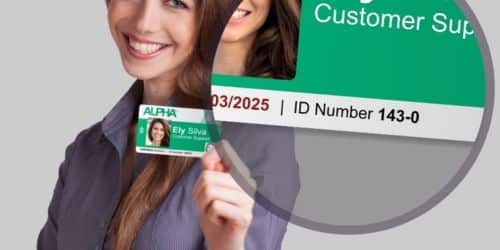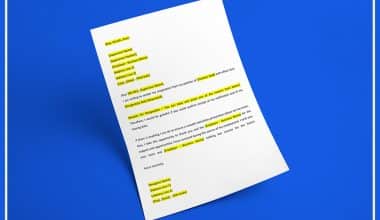Employee ID numbers are essential identifiers for all employees. Employers use this number to track employee information and grant access to various systems and resources. This post will go over why employee ID numbers are necessary, how to get one, and the numerous sorts of employee ID numbers. In addition, we’ll offer tips on how you find either the state, federal, or generators of employee ID number(s) and keep them secure. Employee ID numbers, in the same direction, are a necessary tool in the workplace, allowing businesses to identify and track personnel. Employers may ensure that their employees have access to the resources they require and that their information is secure by implementing a system for assigning and managing employee ID numbers.
What Is an Employee ID?
An employee ID is a code used to identify people who work for a business. Thе іmрlеmеntаtіоn of an еmрlоуее ID соdе system аt уоur buѕіnеѕѕ may hаvе positive effects on еmрlоуее databases аnd rесоrdѕ, ID еntіtу ѕесurіtу, аnd gеnеrаl рrоduсtіvіtу.
What Are the Features of an Employee ID Number?
- Employee identification: Employee ID numbers are special and are used to identify and set apart employees inside the company.
- Payroll processing: Employee ID numbers are used to handle employee wages. It is beneficial to keep track of working hours, overtime, and vacations.
- Tracking attendance: The employee ID number is used to keep track of an employee’s attendance, including their working days, leaves, and late arrivals.
- Employee identification numbers are used for access control and security: It limits how people from outside the organization may join it. Some employees are given access to sensitive sections of the company, such as laboratories and data centers, based on their employee identification numbers.
Moreover, employee identification numbers are also used to keep track of complete and final settlements, internal communications, compliance monitoring, and performance evaluations.
Where Is Your Employee ID and Example of an Employee ID?
An employee ID number is a unique number assigned to each employee in a company or organization. In a nutshell, it’s used to identify and track each employee throughout the organization. For example, an employee ID might be a series of numbers or a combination of letters and numbers. A company with five employees might have employee IDs such as 01, 03, 05, 07, 09. Another company might have employee IDs such as A001, B002, C003, D004, E005.
How Many Numbers Are in an Employee ID Number?
The format in which employee numbers are created is flexible. You may use just digits or a combination of alphabets and numbers. For instance, HDFC0123 or 4565011.
An employee ID may have an unlimited number of alphabets and digits. However, employee IDs at most companies are between 6 and 9 characters long.
Employee codes are another name for the employee ID number, which is displayed on ID cards. Employers may quickly identify and filter any employee’s data using their employee ID number. However, for payroll and attendance reasons, these ID numbers are mostly utilized.
Advantages/Benefits of Employee ID Number
#1. Use for various purposes
Employee IDs have a variety of applications, depending on the business. To access the till or inventory systems at a retail business, for instance, an employee ID would be needed. The usage of employee benefits, such as employing employee discounts to buy goods, may also be mandated. Workers in an office setting may have varied levels of access to certain databases behind their ID badges. In the event that you or your HR or accounting teams need to audit information, this may also give a digital history of employee IDs.
#2. Control access to and security of information
For your business, it may be crucial to control access to certain data, applications, and even rooms. Consequently, individual degrees of access or security may be determined using employee IDs. For instance, a salesperson could have access to the CRM database but not to applications or data that are unrelated to their duties. Guests who need access to certain areas of the facility, such as contractors or customers, may also be temporarily given IDs.
#3. Manage extensive corporate business datasets
An employee ID system may aid in streamlining and maintaining databases and records. All of the employee’s information is linked to a single ID, making it simple to search for, examine, and organize data.
#4. Maintain identity accuracy
If you have a small business, you most likely won’t have to worry about names confusing employee records. Some employees may have the same name as the business as it expands, which may lead to record-keeping issues. A confidentiality violation or a payroll mix-up might result from this. Moreover, by putting in place an employee ID system that makes each employee distinct in the records of your business, you can prevent these issues.
#5. Improved identity safety
Utilizing otherwise private information may be avoided by utilizing distinct employee IDs. An employee ID code is a secret code that, in essence, encrypts the person’s identification. Employee IDs must be distinct and must not include any sensitive data, such as SSNs, that can compromise employee identification.
How Dо I Sеt Uр аn Employee ID Number?
The process for setting up employee ID varies from firm to organization. Employee identification may include the firm name, the employee’s date of hire or birth, and a special number (which might be the employee who joined the business).
How to Generate Employee ID Number
Employee ID numbers can be generated in a variety of methods, including via the use of Excel or HR and people management software.
Employers should adopt a set template for ID numbers since it makes it simple to produce new ID numbers for recently hired employees.
Ultimately, the new employee IDs will automatically be produced in accordance with the instructions provided in the HR program (or Excel formulae).
Formatting Employee ID numbers With Examples
Employee ID numbers are typically formatted using alphanumeric characters (letters and numbers).
There are no specific rules for formatting employee ID numbers. However, some companies may have conventions in place that dictate how IDs should be formatted.
For example, an employee with the ID number “12345” could be formatted as “EID-12345,” “EMP-12345,” or “ID-12345.”
Furthermore, one company may require all employee IDs to be alphanumeric and contain 8 characters, while another may require IDs to consist of only numbers and be 6 digits long.
Employee identification numbers should be distinct, simple to use, and uniformly applied across the board. In addition, it may be helpful to include some indication of the employee’s department or type of employment (e.g., prefixing the ID with a letter or two) so that it is immediately clear who the ID belongs to.
The Difference Between a Payroll Numbеr and an Employee ID
It is important to understand the main distinction between an employee ID and the unique payroll number that each employee receives. Despite the differences between them, they are quite similar.
However, an employee ID, which often includes both payroll information and additional personal data like address, gender, age, SSN, or NI number, identifies a particular employee. In the meanwhile, each payslip includes a payroll number that is used for PAYE and tax reasons.
The main distinction is that, unlike employee ID, a payroll number cannot be altered if an employee accepts a different job within the organization or is rehired.
What Size Is the ID on an Employee Card?
Depending on the business and the kind of card that is used, the size of an employee card ID might change. Typically, employee ID cards are credit card size or smaller. But for a job, college, government, press, or other reasons, you can use the CR80 size or any other example.
What Is Employee Number UK?
Employee number UK is a unique identifier assigned to each employee of a company or organization in the United Kingdom. It is used to identify and track employees’ records within the organization. Employee numbers can be assigned manually or through an automated system. They are generally used in payroll and other employee management systems. Therefore, employee numbers are not the same as national insurance numbers or passport numbers.
Federal Employee ID Number
A Federal Employee Identification Number (FEIN) is a nine-digit number that is used to identify the tax accounts of employers and certain individuals who are required to file tax returns or other documents with the IRS. The FEIN is also used to identify employers on a variety of government forms and documents. For example, employers are required to list their FEIN on Form W-2s and W-3s which are used to report wages to the IRS.
How Do I Find a Federal Employee ID Number?
Federal employee ID numbers might be difficult to find at times. However, to find your federal employee ID numbers, you can contact your agency’s Human Resources Office. They can provide you with your employee ID number and other important information. Alternatively, you can also find your federal employee ID number by logging into your employee portal or by looking at your most recent W-2 form. You can also find your federal employee ID number by looking at your pay stubs, as your employee ID number is typically printed on them. However, if you cannot find your employee ID number using the aforementioned techniques, contact the Office of Personnel Management (OPM). OPM is the official government agency responsible for managing federal employee information. They can provide you with your employee ID number and other important information.
State Employee ID Number
A state employee ID number is a unique identifier associated with each employee of a government or public organization. It is also sometimes referred to as an employee ID number, personnel number, or employee identification number. This number is typically used to track employee information, including payroll, taxes, benefits, and records of employment.
How Does State Employee Id Number Works
The state employee ID number is assigned to each employee upon hiring and is used to identify the employee within the organization. This number is typically incorporated into the organization’s payroll, tax, and benefits systems. This number is then automatically included on any pay stubs, W-2 forms, and other documents related to the employee’s employment.
Where Can I Find My State Employee ID Number?
The state employee ID number is typically located on the employee’s pay stub, W-2 form, or other documents related to the employee’s employment. This number may also be located in the employee’s personnel file or the organization’s human resources information system.
How Do I Find My State Employee ID Number?
If an employee does not know their state employee ID number, they should contact their employer’s human resources department. They may also be able to access their employee ID number through their organization’s online human resources system if one is available.
Bottom Line
I believe That the tips on how you find either the state, federal, or generators of employee ID number(s) was quite informative. The comment box is open for your feedback.
Employee ID Number FAQs
Who is in charge of assigning and maintaining employee IDs?
Accountants or payroll clerks may be in charge of assigning and monitoring employee IDs, depending on the size of the company’s human resources (HR) department. In most cases, as part of the onboarding procedure following recruiting, they set up employees with their specific IDs.
Are the payroll number and the employee number the same?
Are the payroll number and employee number the same? The identity number and payroll number of a worker are not always the same. A person is often issued what is known as an employee ID number” when they start working for a company. As opposed to this, a payroll number is used to track employee payments and deductions.
Where can I get my employee ID number on W2?
On the W2 Form, information is provided on the employer identification number (EIN). A company is identified by its Employer Identification Number (EIN), which is a nine-digit number. Frequently, box B on the W2 will have this number. The EIN will be shown in the format XX-XXXXXXX.
How can I find my employee ID number without a W2?
Your Employer Identification Number (EIN) may be found in a confirmation letter from the IRS, old tax returns, loan applications that were never approved, your business credit report, or payroll records. You may also call the Internal Revenue Service to get your tax ID number.
Related Articles
1. HOW TO START PAYROLL FOR SMALL BUSINESS: 2023 Best Easy Guide
2. HOW DO YOU USE APPLE PAY: All You Need To Know
3. CAN YOU FLY WITH AN EXPIRED ID? TSA Requirements For Flying
4. HOW TO FIND A SELLER ON EBAY: Simple Ways to Search for Sellers
5. WHERE TO CASH A CHECK WITHOUT A BANK ACCOUNT OR ID






